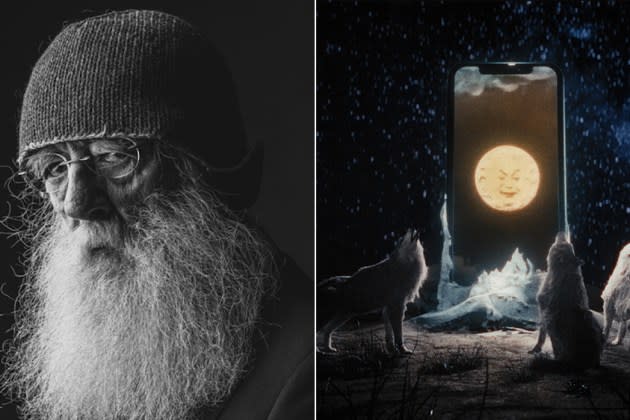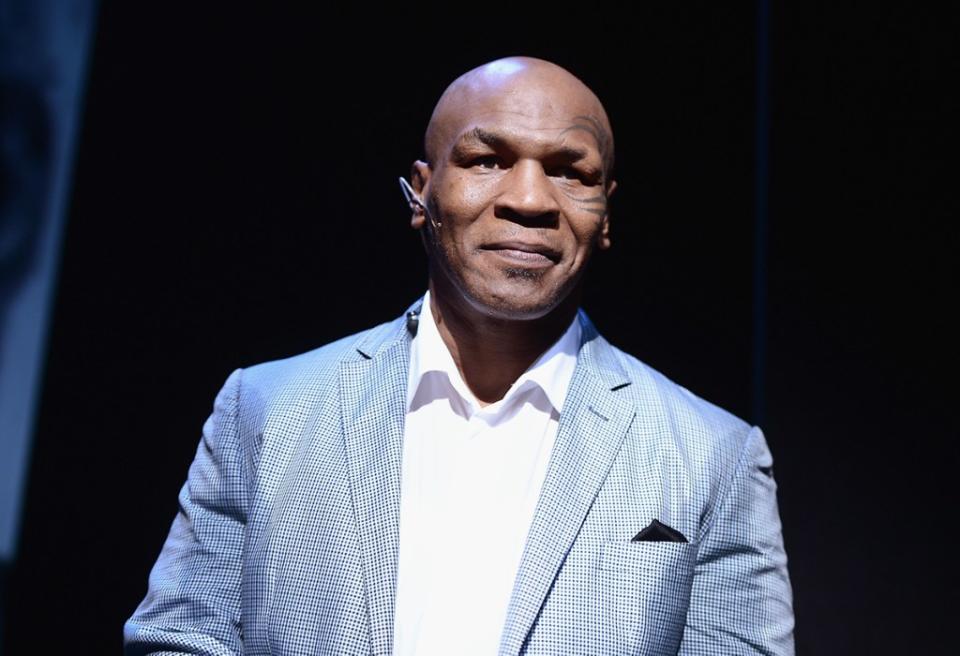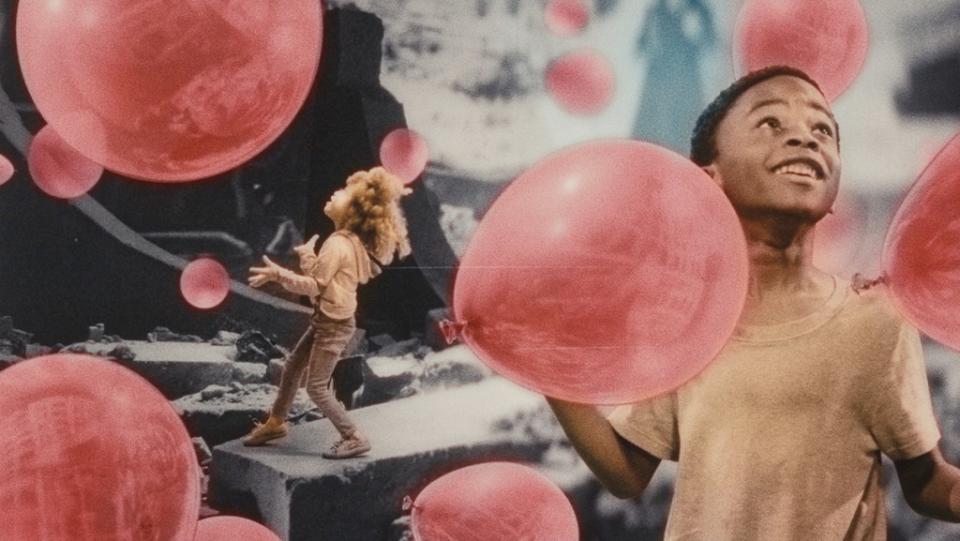‘Koyaanisqatsi’ Director Godfrey Reggio Unravels His New Odyssey ‘Once Within a Time’ Amid Humanity’s Accelerating Self-Destruction

Stop reading if you’ve seen this movie before — a wooden mannequin with the face of Greta Thunberg greets a horde of kindergarteners emerging from a steampunk Trojan horse under a dome of gigantic smartphones bathing them in hot blue light.
Alright, keep scrolling.
More from Variety
That singular image is one of the many goofy but eerie arrangements that Godfrey Reggio conjures in his newest odyssey, “Once Within a Time” — a dense, trance-inducing 43-minute feature that sees the “Koyaanisqatsi” director sounding the alarm on the technocratic foundations of our digital age.
“No festival wanted this film,” Reggio tells Variety, smoking American Spirits and sporting a gray bushy beard while speaking on a Zoom call in his Sante Fe, N.M. studio. “Not even Telluride, where they celebrated the 40th anniversary of ‘Koyaanisqatsi.’ They didn’t know what to make of it.”
Perhaps the festivals could be forgiven, as implied meaning isn’t exactly the modus operandi for “Once Within a Time.” Reggio describes his new project with a series of paradoxes: “linear and nonlinear, clear and ambiguous at exactly the same time.” Without any dialogue, the film flutters between recognizable myths (The Garden of Eden! The Tower of Babel! A giant robot battling the military in the desert!), unfurling a dreamy tapestry under a confetti blast of digital distortions.
The experience is “aimed at your subconscious,” says Reggio. The director says he’s been wanting to make “Once Within a Time” for over 40 years after first being inspired by Luis Buñuel’s feverish surrealist classic “Los olvidados,” but he couldn’t crack how to make it without narration for several decades. Despite its long journey, the film goes out of its way to be contemporary. (Emojis: check.) At once a wail of techno-pessimism and a cavalcade of special effects, “Once Within a Time” continues Reggio’s tradition of “fighting with fire,” using filmmaking technology to warp the industrial world and lay bare its unnatural depravity.
“Art should be painful. It’s like if you have a boil, you want to lance it to get the pus out. Art should be like an art-opsy,” Reggio jokes. “It releases the tension. Art’s not a happy thing.”

“Once Within a Time” opens in New York and Los Angeles this month, with event screenings accompanied by Q&As with executive producer and Reggio champion Steven Soderbergh. A platform release will follow. The theatrical rollout returns Reggio to the big screen, just over 40 years after he debuted his first feature “Koyaanisqatsi” — a title derived from a Hopi language phrase meaning “life out of balance.” That dizzying menagerie of sweeping natural landscapes and accelerated footage of human civilization grossed $1.7 million at the box office — a healthy sum for an arthouse film at the time — and garnered adoration from critics and stoned college students alike.
Reggio, one of the rare experimental filmmakers to make a crossover into the mainstream, has stated previously that he felt compelled to make “Koyaanisqatsi” because he was haunted by the apprehension that humans were creating “a world that was upside-down.” It’s a sentiment that Reggio hasn’t shaken after four decades.
“It’s only become more intense. Every film I make is like making butter, churning around the same tree of technology. Technology’s not something we use — it’s as ubiquitous as the air we breath,” Reggio says. “There was a covenant between those that ate and those that were eaten— and I’m not talking about Perdue fried chicken here. We are predators. There was a holy alliance between the eaten and the eaters. That’s disappeared today… We’re a virus. We came here as a fucking virus. Okay? So we’re rascals to begin with. We landed here — a perfect place — and we’re fucking it all up.”
Chief among Reggio’s concerns with accelerating technology is the proliferation of AI-generated images on the internet. In that light, the final credit of “Once Within a Time” — “Hand-made in Brooklyn, N.Y. at Opticnerve Studios” — reframes the film as a manifesto against such unnatural creations.
“No images have veracity anymore. They can show the Pope with a big white coat and all of that shit. So there’s nothing real anymore,” Reggio says. “AI has taken over the world. We’re on a ride.”
Unlike “Koyaanisqatsi” and its two follow-ups, “Powaqqatsi” and “Naqoyqatsi,” Reggio’s latest feature leans more toward narrative than documentary. “Once Within a Time” could be interpreted as an episodic journey, with a group of children wandering through various fantastical landscapes. “It’s a family film. You can take the kids to see it. It’s made with kids for all ages,” Reggio says.
But the most conspicuous shift for the filmmaker is his foray into celebrity casting. In “Once Within a Time,” Mike Tyson appears as a character named The Mentor: a smiling, warm guardian that captures the children’s attention and leads them to a sunnier destination. After being enamored by the former boxer’s one-man Broadway show “Undisputed Truth,” Reggio was drawn to the provocative idea of casting Tyson in the feature — specifically because of his criminal history. Tyson was convicted of rape in 1992 and served three years in prison.

“When I said I wanted Mike Tyson, everyone thought I had been drinking or smoking too much — which I did!” Reggio says with a laugh. “I was sure I wanted him because he was a felon. He could speak in a manner of authority. He’s a brilliant person… He doesn’t need a beat. And he did it all for nothing.”
“In the film, he’s a criminal in order to fight criminals,” he elaborates, articulating another paradox to his conception of the project.
“Once Within a Time” also reunites Reggio with regular collaborator Philip Glass. The composer spins another typically throbbing, layered score that unites the film’s disparate interests under one unified pulse. For Reggio, Glass’ music has defined his work, entrancing viewers and inviting them to interpret his images: “His music is like the armchair you sit in. They don’t tell you what they think or what to think. It leaves you free to think.”

With an 86-year-old composer and an 80-year-old director, it’s impressive that Reggio’s producers then gathered a crew for “Once Within a Time” that had the average age of 27. Such a young team was selected out of resourcefulness. Reggio initially rejected $2.5 million in funding, under the presumption that it wouldn’t be enough to fulfill his vision for the film. But he changed his mind an hour later.
“While we don’t look for the best, we looked for those willing to make a bad deal for the love of the project,” Reggio says. “People give me millions of dollars. They don’t know what I’m talking about, but they think I do.”
That’s a dynamic that some viewers will inevitably find themselves in too, as already evidenced by “Once Within a Time’s” rejection from some film festivals. But they aren’t alone; Reggio hasn’t completely figured out his own films either. Though the director has admitted in previous interviews that he doesn’t seek out watching others’ movies, he eagerly continues to retreat into his own to make sense of humanity’s trajectory. He’s eager to invite the world to join.
“I watch my films with Philip all the time. Because each time it’s new,” Reggio says. “Each time I feel the connection in the film and to the other films. I learn by re-seeing it, each time anew. I know that sounds ridiculous, but that’s my favorite thing to do.”
Best of Variety
Sign up for Variety’s Newsletter. For the latest news, follow us on Facebook, Twitter, and Instagram.

 Yahoo News
Yahoo News 
